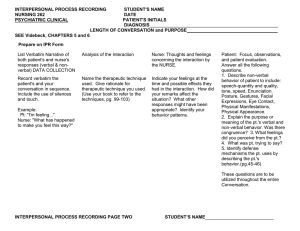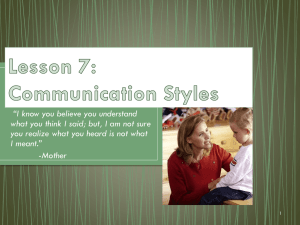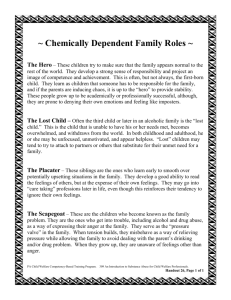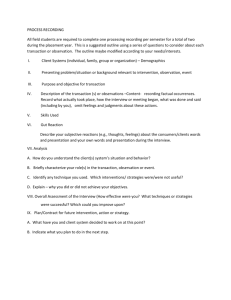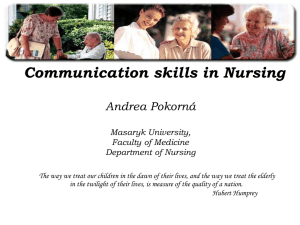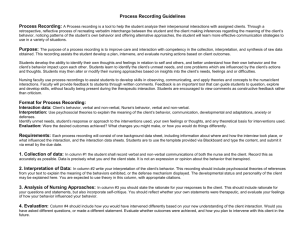Process Recording - Bergen Community College
advertisement
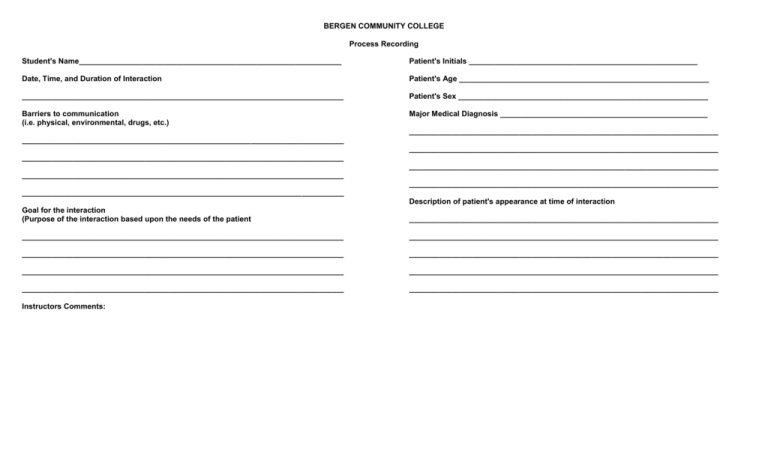
BERGEN COMMUNITY COLLEGE Process Recording Student's Name______________________________________________________________ Patient's Initials ______________________________________________________ Date, Time, and Duration of Interaction Patient's Age ___________________________________________________________ ____________________________________________________________________________ Patient's Sex ___________________________________________________________ Barriers to communication (i.e. physical, environmental, drugs, etc.) Major Medical Diagnosis _________________________________________________ _________________________________________________________________________ ____________________________________________________________________________ _________________________________________________________________________ ____________________________________________________________________________ _________________________________________________________________________ ____________________________________________________________________________ _________________________________________________________________________ ____________________________________________________________________________ Description of patient's appearance at time of interaction Goal for the interaction (Purpose of the interaction based upon the needs of the patient _________________________________________________________________________ ____________________________________________________________________________ _________________________________________________________________________ ____________________________________________________________________________ _________________________________________________________________________ ____________________________________________________________________________ _________________________________________________________________________ ____________________________________________________________________________ _________________________________________________________________________ Instructors Comments: PROCESS RECORDING NURSE'S COMMUNICATION PATIENT'S COMMUNICATION EVALUATION OF COMMMUNICATION TECHNIQUE INTERPRETATION OF COMMUNICATION PROCESS RECORDING GUIDE Nurse's Communications What you said, did and felt: Verbal statements: Exact words and pauses, silences. Use guide for pt's verbal communication. Verbal communication. Were your choice of words easy? Did you find yourself laughing, crying, sighing, yawning? What Pt. says, and does, include: A. Verbal statements: 1. words 2. silences silences. 3. tone of voice 4. sighs, laughs, cries 5. stammers, stutters e 6. pace of speech, etc. B. Non-verbal communications Place observations of your own behavior here. Use guide for pt.'s non-verbal communication. Expressed & Implied Feelings and Thoughts, e.g.: Record those feelings and thoughts you experienced during the interaction. Use the guide for pt.'s feelings and thoughts (See list in Column II-C) SIGNS OF ANXIETY: Evaluation of Communication Technique Patient's Communications C. Interpretation/Evaluation of Communication Therapeutic vs. non-therapeutic: What do you conclude about the communication: 1. Were your statements clear and appropriate? 2. How did you feel during interaction ... were your muscles tense, did you smile too much, did your voice sound funny, did you find it hard to sit still, look into pt.'s eyes? 3. Did you move away from pt., run out of room, etc.? 4. What body language do you need to improve on? How? 5. What feelings did the pt.'s communication trigger? 6. Can you relate your feelings to an event in your past? 7. Can you provide a one word summary for your feelings about this interaction? 8. What are the covert and overt themes? Name the therapeutic technique used Give an alternative technique for the incorrect response Non-verbal communications: 1. facial expressions 2. silences 3. postures assumed 4. gestures 5. eye contact 6. restlessness, yawns 7. attention span, etc. Feelings & thoughts, e.g.: 1. anxiety * 2. anger 3. fearfulness 4. frustration 5. hopelessness 6. loneliness 7. sadness 8. humor 9. love 10. happiness 11. empathy 12. accomplishment, etc. sweating, tightening of muscles, elevated pulse, dilation of pupils, sighing, yawning, increased or decreased flow of speech, inability to make eye contact, change in pacing of speech, changing of topics, trying to focus on the nurse or on details, and when words are in conflict with non-verbal expressions.

